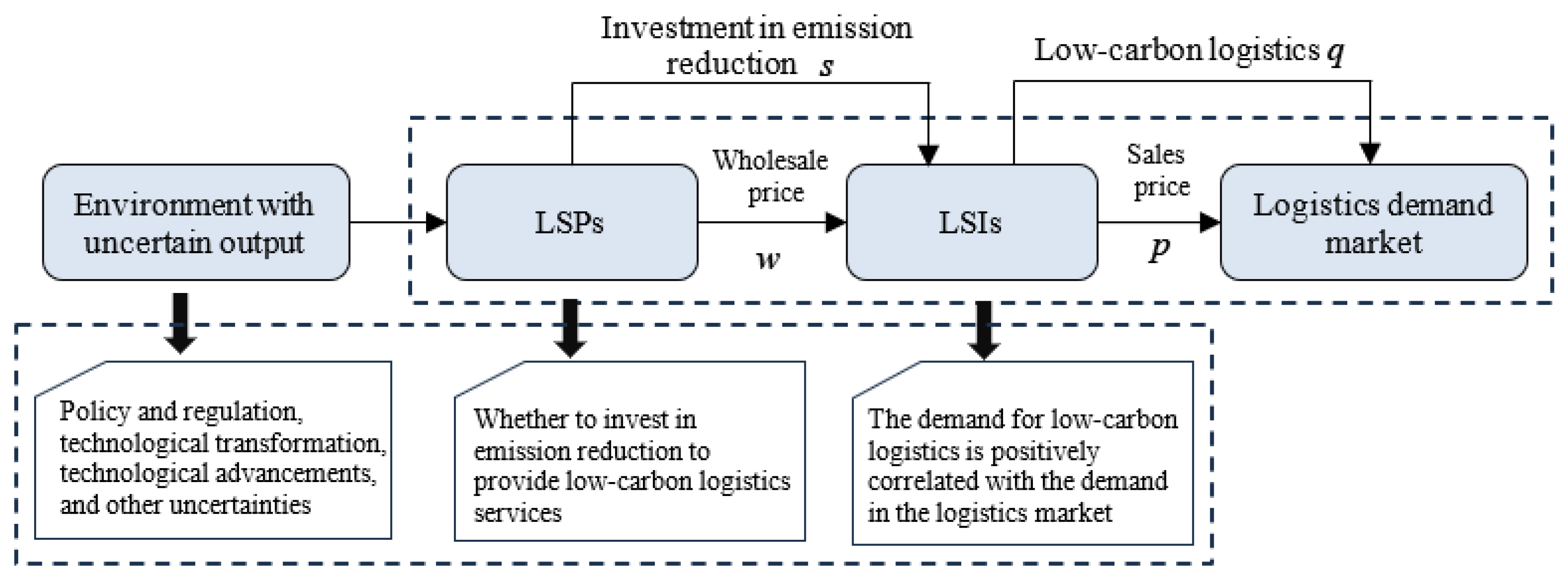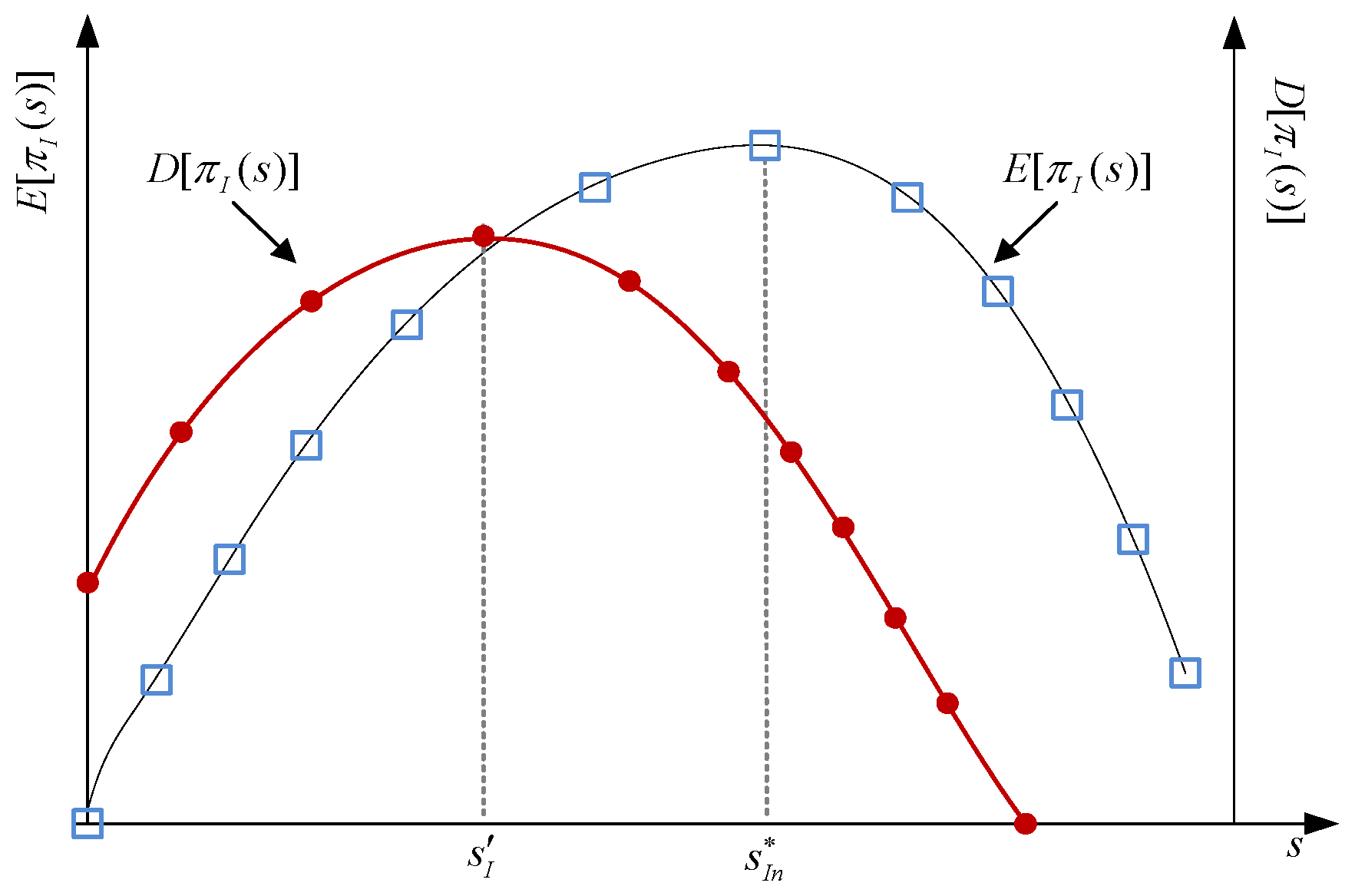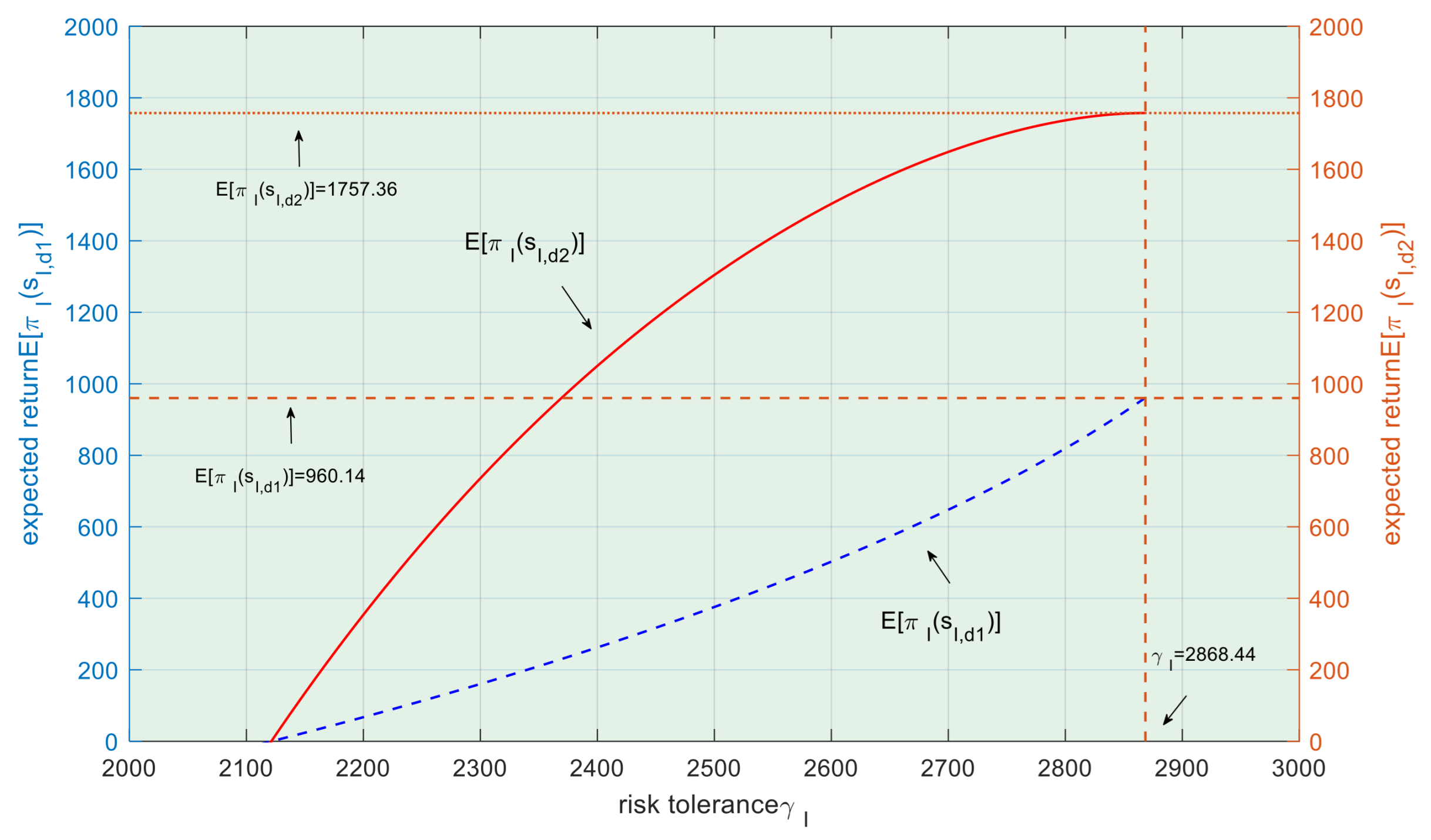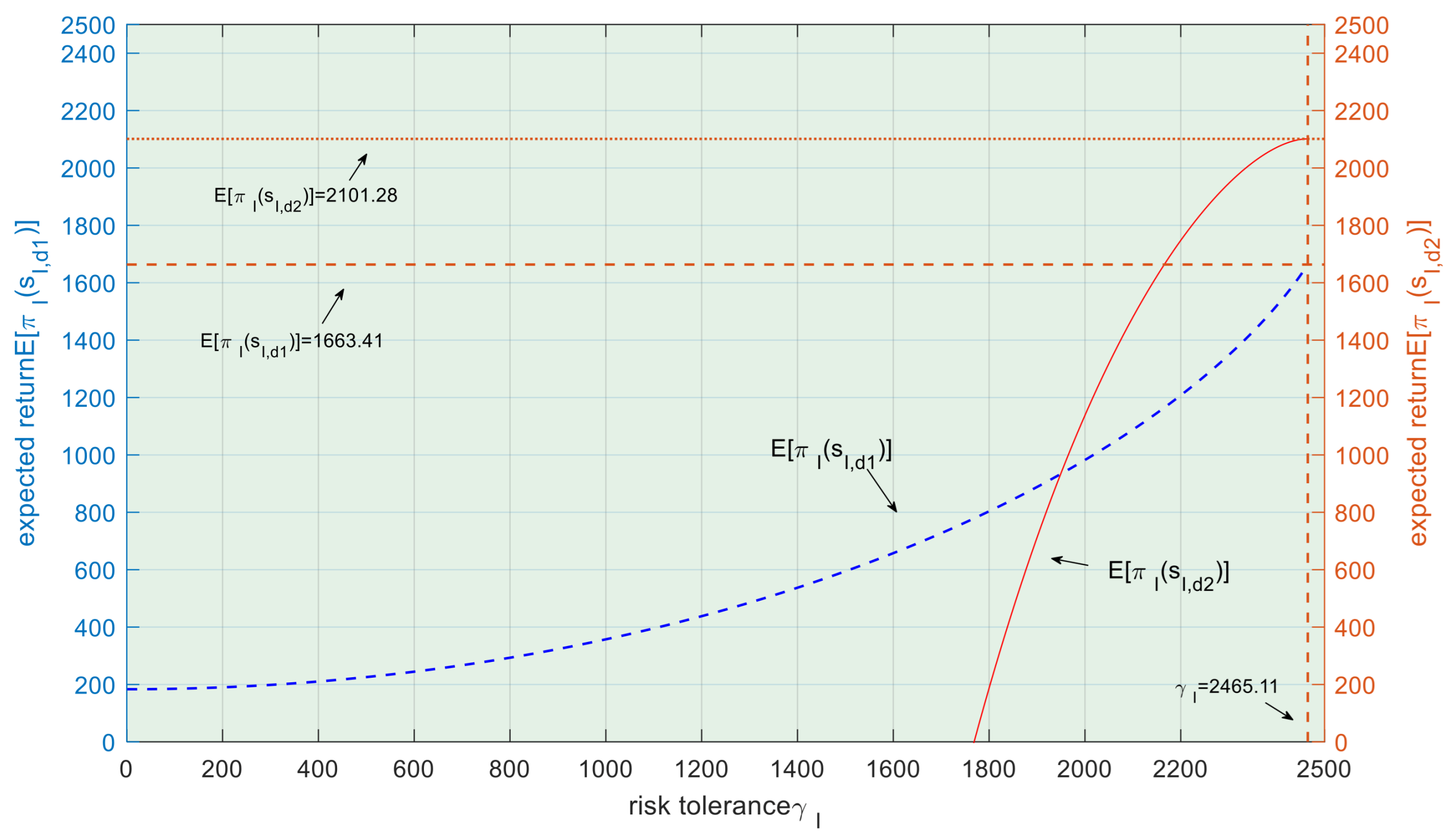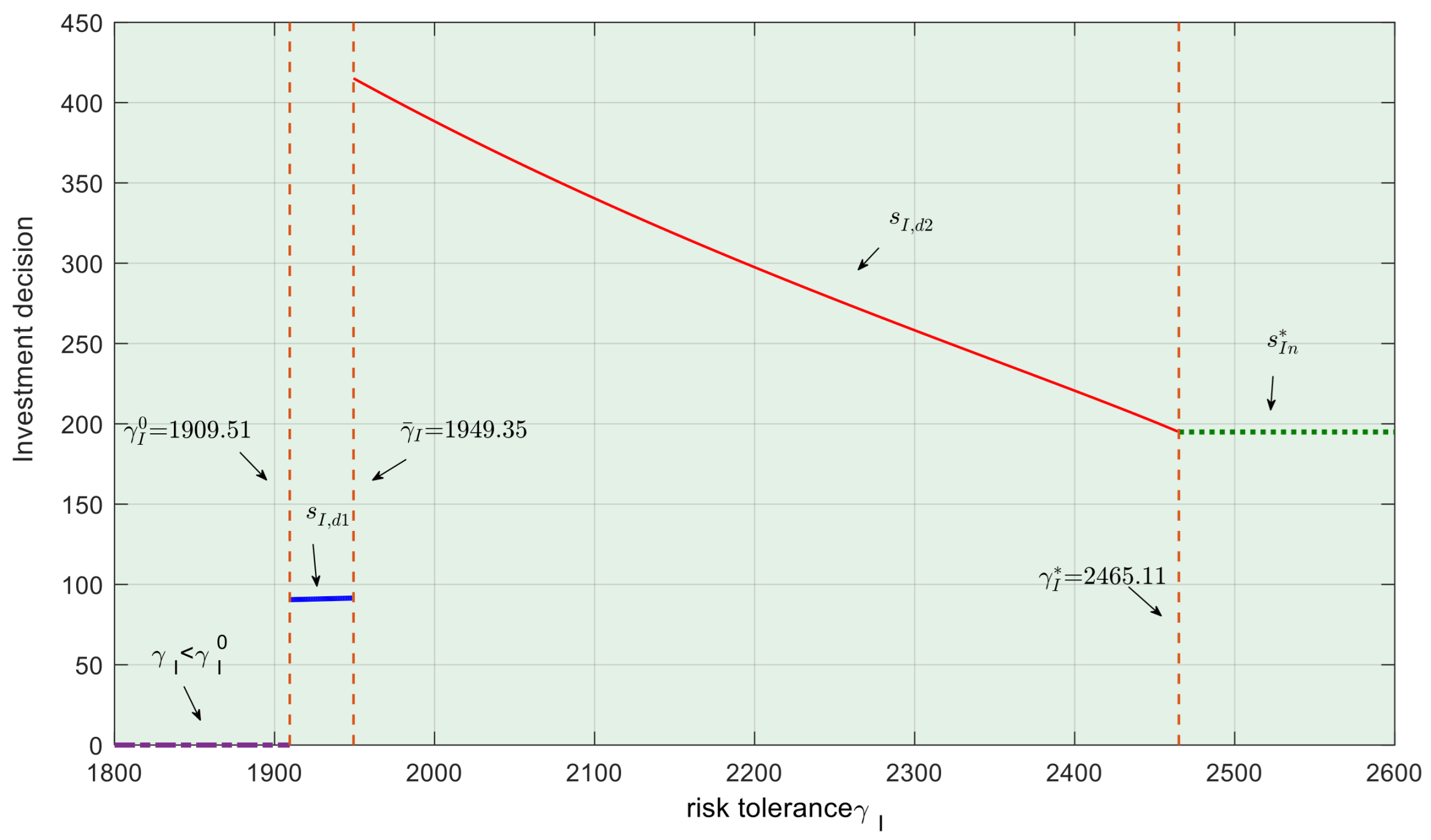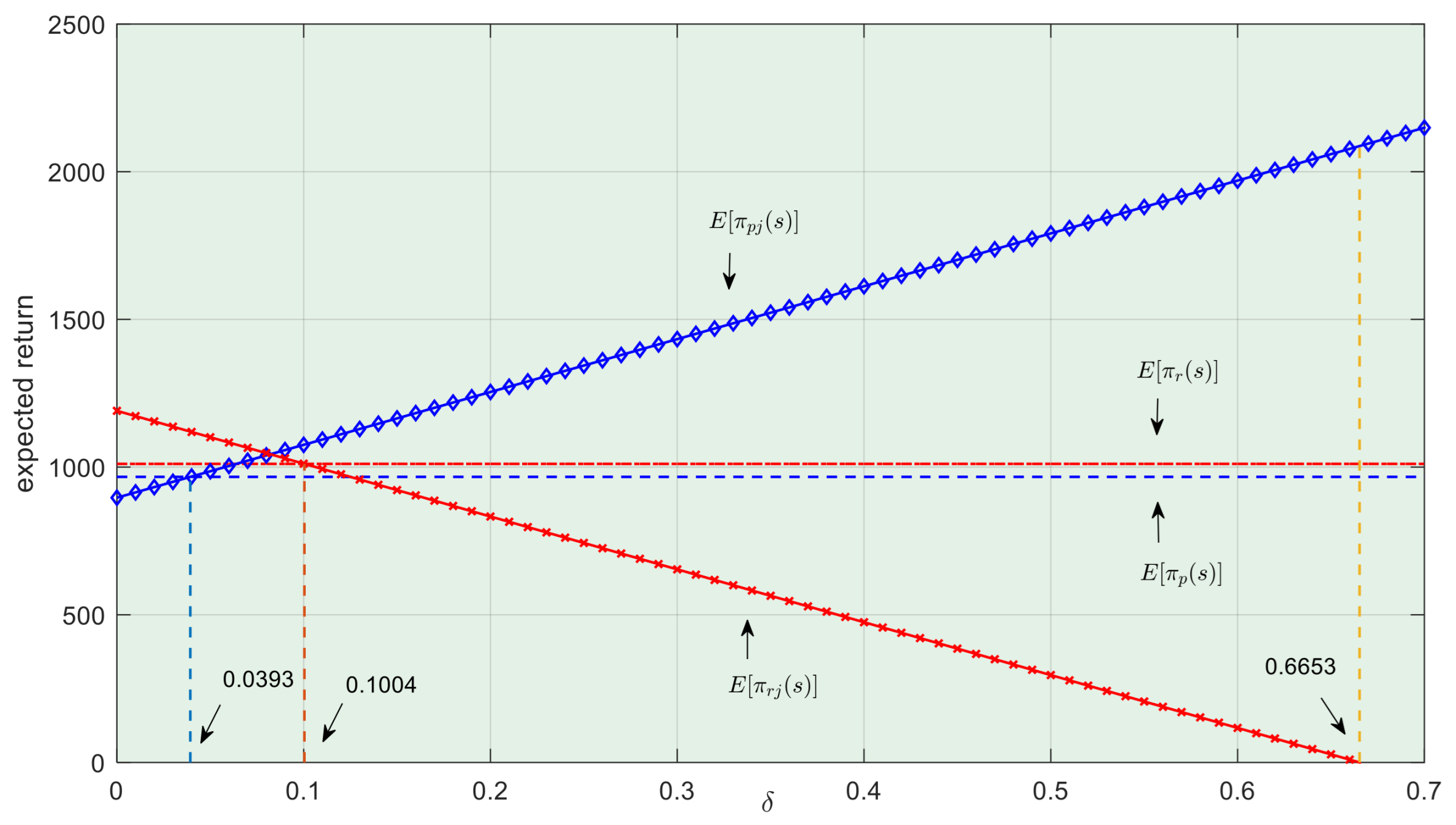3.2. Centralized LSSC Emission Reduction Investment Model
This section constructs a centralized decision model for the LSSC, where it operates as a coordinated whole to optimize overall supply chain revenue. Based on the problem description, Equation (1) represents the revenue expression for the centralized LSSC:
Consequently, the standard deviation of revenue for the centralized LSSC is
, where
is expressed as:
Considering a risk-neutral centralized LSSC, the expected revenue expression is:
Since and , the expected revenue of the centralized LSSC is a strictly concave function with respect to . Therefore, under risk neutrality, the centralized LSSC has a unique optimal emission reduction investment, .
In a risk-averse case, the centralized LSSC can quantify the level of risk tolerance based on the mean-variance model. This paper employs the risk quantification model developed by Chiu et al. and Bai et al. [
25,
26], which uses the maximization of expected revenue,
, as the objective function and the standard deviation of revenue,
, as the risk constraint condition. The mean-variance model expression for the risk-averse centralized LSSC is:
where
and
represent the expected revenue and associated risk for a specific emission reduction investment
within the centralized LSSC, respectively.
reflects the volatility of emission reduction revenue within the centralized LSSC. The expression
shows that as the price of low-carbon logistics
and the penalty for shortages
increase, the risk associated with emission reduction investments in the centralized LSSC continually rises.
denotes the risk tolerance of the centralized LSSC for emission reduction, which has an inverse relationship with the degree of risk aversion, and the LSSC becomes risk-neutral when
.
In practical business operations, the expected revenue from emission reduction investments in the centralized LSSC is . Assuming , solving equation yields two solutions: and . They represent two potential emission reduction investment decisions when the expected revenue of the centralized LSSC is zero. Considering the different risks associated with the two emission reduction investments and , the one with the lower standard deviation between and is chosen as the minimal risk tolerance when . Thus, the risk tolerance of the centralized LSSC must satisfy .
Theorem 1. Under Technical Output Uncertainty, a unique emission reduction investment, , maximizes the revenue risk, , for the centralized LSSC.
Proof. Expression (2) follows , and since , it is evident that . Further differentiation of yields . If , , and increases as increases; if , , and , meaning decreases as increases. Therefore, within interval , has a one-to-one relationship with and initially increases then decreases as increases. Concurrently, since the standard deviation , first increases and then decreases as increases, with a unique maximum at . The proof is complete. □
Based on Theorem 1, in a risk-averse environment, the revenue risk from emission reduction output in the centralized LSSC initially increases and then decreases with an increase in s. An explanation for this pattern is that when the emission reduction investment is at a lower level, the uncertainty in emission output causes the revenue volatility risk in the centralized LSSC to continually increase. As the emission reduction investment continues to increase to a certain level, the output of the LSSC can meet market demand, thereby decreasing the revenue volatility risk caused by Technical Output Uncertainty.
According to Theorem 1, when , the standard deviation of revenue for the centralized LSSC, , has a unique maximum value at . Let . When the risk tolerance of the centralized LSSC , the risk level is high and the LSSC has no risk constraints. In contrast, when , the risk level is low and the LSSC holds risk constraints. When the optimal risk-averse emission reduction investment coincides with the optimal risk-neutral emission reduction investment, the risk tolerance is calculated as .
Theorem 2. Under risk neutrality and risk aversion, the emission reduction investments and in the centralized LSSC satisfy the following conditions: 1) when , ; and 2) when , .
Proof. The optimal emission reduction investment for the centralized LSSC is under risk neutrality and under risk aversion. Comparing and shows that when , , and when , . The proof is complete. □
Figure 3 and
Figure 4 illustrate this section, which depicts the trends in expected revenue and risk associated with changes in the emission reduction investment
, as well as the positioning of different emission reduction investments
and
.
According to Theorem 2, we compare the maximum emission reduction investment risks under risk aversion , risk neutrality , and zero expected revenue .
Proposition 1. Under different risk attitudes, the emission reduction investment risks in the centralized LSSC satisfy .
Proof. (1) Based on Theorem 2, when , . For , the emission reduction investment risk in the LSSC is a monotonically decreasing function of , thereby .
(2) Similarly, when , . For , the emission reduction investment risk in the LSSC is a monotonically increasing function of , thereby .
Hence, under different risk attitudes, the emission reduction investment risks in the centralized LSSC persistently satisfy . The proof is complete. □
According to Proposition 1, under Technical Output Uncertainty and when the LSSC’s emission reduction investment risk is at its maximum, the highest possible expected revenue is not higher than the emission reduction investment risk at the maximum expected revenue. This deviates from the classic input-output theory notion that “higher risk usually accompanies higher profit, while lower risk implies lower profit.” This indicates that under Technical Output Uncertainty, decision-makers in a risk-averse centralized LSSC cannot simply choose the optimal emission reduction investment based on general input theory, as the highest-risk emission reduction investment does not necessarily yield the highest expected revenue.
Considering the risk attitude of the centralized LSSC, in a risk-averse scenario, the decision-maker’s emission reduction investment is constrained by their level of risk tolerance, and the expected revenue may not achieve the optimal expected revenue . Concurrently, when the emission reduction investment risk tolerance of the centralized LSSC is (), let be the decision-maker’s optimal decision when . From earlier discussions, and from the expression for the standard deviation of revenue for the centralized LSSC, the emission reduction investment at risk tolerance is or . The expected revenues correspond to the emission reduction investments and are, respectively: , . Hence, the expected revenues from the two types of emission reduction investments in the centralized LSSC are not necessarily equal. At this point, equating , represents the risk when the two types of emission reduction investments achieve the same expected revenue, calculated as . Further analysis based on under different values can lead to Proposition 2.
Proposition 2. Under Technical Output Uncertainty, the optimal emission reduction investment in the centralized LSSC satisfies the following conditions:
(1) When , ;
(2) When , , where:
(a) If , then ;
(b) If :
When , then ; when , then ; and when , then .
(c) If , then .
Proof. (1) When , the quasi-concave nature of the revenue standard deviation in the centralized LSSC means that the optimal emission reduction investment is equal to that during risk neutrality, i.e., .
(2) When , , the following cases apply:
(a) If , the expected revenue of the LSSC necessarily satisfies ; thus, the optimal emission reduction investment is .
(b) If :
When , the expected revenue necessarily follows , thus .
When , the expected revenues are equal, , thus .
When , the expected revenue satisfies , thus .
(c) If , the expected revenue necessarily follows ; then the optimal emission reduction investment is .
The proof is complete. □
According to Proposition 2, under Technical Output Uncertainty, optimal emission reduction investment decision for the centralized LSSC depends on its own risk tolerance . When the LSSC has a high-risk tolerance (), the optimal emission reduction investment is unconstrained by risk, and its value is equal to the optimal investment under risk neutrality. In contrast, when it has a low-risk tolerance (), the optimal emission reduction investment is constrained by risk. In the latter case, the decision is required to be between and to yield the highest expected revenue. Given investment , the LSSC faces the risk of a capacity shortfall, primarily the risk of revenue loss and penalties due to insufficient capacity. Conversely, by choosing investment , the LSSC faces the risk of capacity redundancy, primarily the risk of revenue loss due to excess capacity. When the LSSC’s risk tolerance is , choosing between and is indifferent, implying an equal revenue loss from capacity shortfall and redundancy with and , respectively. Thus, unlike with a risk-neutral attitude, when adopting a risk-averse attitude, the centralized LSSC needs to assess its own risk tolerance. If its risk tolerance is high, its emission reduction investment decision is not constrained by risk. Conversely, if its risk tolerance is low, its decision must weigh the expected revenues of different investments to determine the optimal investment.
Proposition 3. Under Technical Output Uncertainty, if the risk tolerance of the centralized LSSC ranges within , the relationship between the risk tolerance and the optimal emission reduction investment is as follows: and are monotonically increasing and decreasing functions of , respectively.
Proof. From Proposition 2, if
, the optimal emission reduction investment
for the centralized LSSC is either
or
. Since both
and
are functions of
, solving their first derivatives yields:
Hence, and . Accordingly, if , and satisfy the following relationship: and are monotonically increasing and decreasing functions of , respectively. The proof is complete. □
Based on Proposition 3, under Technical Output Uncertainty, if the centralized LSSC is constrained by risk , its optimal emission reduction investment, , is related to its risk tolerance, . When the optimal emission reduction investment is , the LSSC faces revenue losses due to capacity shortfall. Using Theorem 2, as the emission reduction investment increases, the revenue risk also continuously increases. Therefore, as increases and the LSSC has a higher risk tolerance, the supply chain will increase its emission reduction investment to reduce the risks associated with capacity shortfalls, thereby achieving higher expected revenues. When the optimal emission reduction investment is , the LSSC faces revenue losses due to capacity redundancy. Moreover, based on Theorem 2, as the emission reduction investment increases, the revenue risk continuously decreases. Thus, as increases and the LSSC possesses a higher risk tolerance, the supply chain will decrease its emission reduction investment to minimize the risks associated with capacity redundancy, thereby securing higher expected revenues.
3.3. Decentralized LSSC Emission Reduction Investment Game Model
This section analyzes the decentralized decision-making model of the LSSC, an important form of supply chain management that differs from the centralized LSSC in terms of organizational structure and operational mode. In a decentralized LSSC, the LSP and LSI operate independently, each aiming to maximize their individual interests, disregarding the impact on other members. Based on the assumptions described in the problem statement, Equation (4) constructs a game model under risk neutrality to provide an expected revenue expression for the LSP.
Similarly to the centralized LSSC, as
and
, the expected revenue
for the LSP is a strictly concave function of
. Under risk neutrality, the LSP holds a unique optimal emission reduction investment,
. Additionally, to quantify the risk aversion of supply chain members, the standard deviation for the LSP’s revenue is
, using the mean-variance model. Similarly, the expected revenue expression for the LSI is:
The standard deviation for the LSI, , and for , the decentralized LSSC’s emission reduction risk is equal to the sum of the emission reduction risks of the LSP and LSI, i.e., . This demonstrates that in the process of emission reduction investment within the LSSC, the risk caused by Technical Output Uncertainty does not change with the operational mode of the supply chain.
Considering that in the LSSC, the LSP is primarily responsible for emission reduction investments and bears the negative impacts caused by Technical Output Uncertainty, this article focuses on discussing the emission reduction investment model of the LSP under varying risk attitudes. It assumes a risk-neutral attitude for the LSI, implying that no risk constraint exists in decision-making.
Similarly to the decision-making model of the centralized LSSC, the mean-variance model expression for the LSP when considering risk aversion can be constructed as:
where maximizing the expected revenue of the LSP,
, serves as the objective function, with the revenue standard deviation
as the risk constraint,
represents the risk tolerance of the decentralized LSP, where risk tolerance is inversely related to the degree of risk aversion, and
denotes the risk tolerance when the LSP’s expected revenue is zero, with operational reality requiring
, and as
, the LSP is risk-neutral.
Given that under risk neutrality the only optimal emission reduction investment for the LSP is , at this point, its risk tolerance is , i.e., . Similarly to Theorem 1, under Technical Output Uncertainty, a unique emission reduction investment exists that maximizes the revenue risk for the decentralized LSP, . Comparing the decentralized LSP’s emission reduction investments and under different conditions: (1) when , and (2) when , .
Proposition 4. Under different risk attitudes, the emission reduction investment risk for the decentralized LSP satisfies .
Proof. (1) As per Theorem 2, when , because for , the emission reduction investment risk for the decentralized LSP is a monotonically decreasing function of , thus .
(2) Similarly, when , because for , the emission reduction investment risk for the decentralized LSP is a monotonically increasing function of , thus .
In summary, under different risk attitudes, the emission reduction investment risk for the decentralized LSP is . The proof is complete. □
Similarly to Proposition 1, according to Proposition 4, under Technical Output Uncertainty, the expected revenue at the maximum risk of emission reduction investment by the LSP does not exceed the risk at the highest expected revenue. Therefore, under the background of Technical Output Uncertainty, it cannot be assumed that the highest-risk emission reduction investments by a decentralized LSP will yield the highest expected revenue when adopting a risk aversion strategy.
When the risk tolerance of the decentralized LSP is (), let represent the LSP’s optimal decision within this range. Also, let ; the emission reduction investment for the LSP when its risk tolerance is can be either or . The expected revenues corresponding to these investment decisions are and . By setting , signifies the risk at which the LSP achieves the same expected revenue for both types of investment and is given by: . Further exploration into the optimal emission reduction investment, , establishes Proposition 5.
Proposition 5. Under Technical Output Uncertainty, the optimal emission reduction investment, , for a decentralized LSP meets the following conditions:
(1) When , ;
(2) When , , where:
(a) If , then ;
(b) If , when , ; when , ; and when , .
(c) If , then .
Proof. The proof of Proposition 5 follows a similar logic to that of Proposition 2. □
According to Proposition 5, under Technical Output Uncertainty, the optimal emission reduction investment decision for a decentralized LSP depends on its own risk tolerance . When the risk tolerance of the LSP is high, (), no risk constraint exists on the optimal investment, and its value equals that in the risk-neutral scenario. When the LSP’s risk tolerance is lower, (), the optimal investment faces risk constraints, balancing between and . If choosing results in a greater loss from insufficient capacity compared to the excess capacity loss from , the decision-maker opts for ; otherwise, is chosen. When the risk tolerance of the LSP is at , the outcomes of choosing or are financially equivalent, thus the decision-maker may select either without preference.

